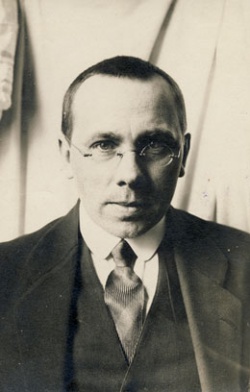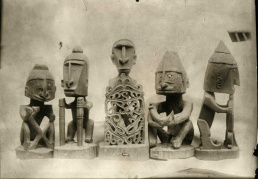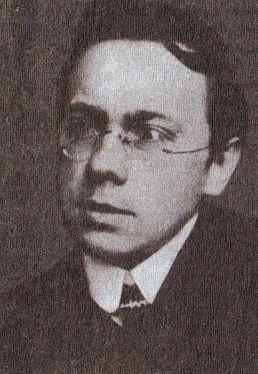Difference between revisions of "Voldemārs Matvejs"
| Line 35: | Line 35: | ||
* "Chinese Pipe", 1914. | * "Chinese Pipe", 1914. | ||
* ''Cследование Маркова «Искусство острова Пасхи'' [The Art of the Easter Island], 1914. | * ''Cследование Маркова «Искусство острова Пасхи'' [The Art of the Easter Island], 1914. | ||
| − | * '' | + | * ''Iskusstvo negrov'' [Искусство негров; Negro Art], 1919. [http://www.auction-imperia.ru/wdate.php?t=booklot&i=18539] |
* ''The Art of Northern Asia'', unfinished. | * ''The Art of Northern Asia'', unfinished. | ||
| Line 56: | Line 56: | ||
* Irēna Bužinska, "Voldemārs Matvejs", ''Studija'' 7 (1999), pp 88-91. (in Latvian) | * Irēna Bužinska, "Voldemārs Matvejs", ''Studija'' 7 (1999), pp 88-91. (in Latvian) | ||
* Irēna Bužinska, "Dažas piezīmes par Voldemāru Matveju ― gleznotāju, teorētiķi, fotogrāfu", ''Latvijas Zinātņu Akadēmijas Vēstis'' 2/3 (2002), pp 30-38. (in Latvian) | * Irēna Bužinska, "Dažas piezīmes par Voldemāru Matveju ― gleznotāju, teorētiķi, fotogrāfu", ''Latvijas Zinātņu Akadēmijas Vēstis'' 2/3 (2002), pp 30-38. (in Latvian) | ||
| + | * ''Волдемар Матвей и "Союз молодежи"'', Nauka, 2005, 450 pp. | ||
* Irēna Bužinska, "Nākotnes mākslu meklējot: Voldemārs Matvejs ārpuseiropas kultūru pētniecības un 20. gs. sākuma zinātnes atklājumu krustceļos" [In Search of a New Art: Voldemārs Matvejs at the Crossroads of Exploring Non-European Culture and Scientific discoveries in the Early 20th Century], ''Art History and Theory'' 13, 2010. (in Latvian) [http://www.ceeol.com/aspx/issuedetails.aspx?issueid=9ac1de96-a997-4ba4-a152-1e9a5c454499&articleId=45d67378-8627-4563-904b-4c03d84573d1] | * Irēna Bužinska, "Nākotnes mākslu meklējot: Voldemārs Matvejs ārpuseiropas kultūru pētniecības un 20. gs. sākuma zinātnes atklājumu krustceļos" [In Search of a New Art: Voldemārs Matvejs at the Crossroads of Exploring Non-European Culture and Scientific discoveries in the Early 20th Century], ''Art History and Theory'' 13, 2010. (in Latvian) [http://www.ceeol.com/aspx/issuedetails.aspx?issueid=9ac1de96-a997-4ba4-a152-1e9a5c454499&articleId=45d67378-8627-4563-904b-4c03d84573d1] | ||
Revision as of 00:33, 7 February 2014
 Matvejs in c1912. | |
| Born |
October 13, 1877 Riga, Latvia |
|---|---|
| Died |
May 16, 1914 (aged 36) St. Petersburg, Russia |
Also Vladimir Ivanovich Markov; Владимир Иванович Марков; Voldemar Janovič Matvej; Hans Waldemars Yanov Matvejs; Valdemars Matvejs. Latvian artist and art theorist, active in Russia.
Born 1877 in Riga. In 1895-1902 he studied at the private art school of Benjamin Blum in Riga. For two years he worked as a teacher in Tukums. After that he moved to St. Petersburg and in 1905 entered the Academy of Arts as a student of landscape painting. In 1906-07 he attended the private painting studio of the Polish artist Yan Tsionlinsky. He graduated Academy in autumn 1914. [1]
As the principal spokesman for the St Petersburg art society, the Union of Youth (1910–14), Matvejs published articles defending the group’s artistic experiments, organized its early exhibitions and travelled to western Europe to establish links with the German and French avant-garde (Walden, Kandinsky, Marc). [2]
Matvejs spent on these travels every summer from 1910 to 1913 and he also used them as an opportunity to study medieval art, Negro art (sculpture), and French modernism. In 1909 he visited the Swedish island of Gotland and was fascinated by the medieval city of Visby and the Early Gothic sculptures there. In 1911 he travelled throughout Italy. In 1912 he was in Paris, Berlin and Cologne. The Union of Youth partly subsidised Matvejs' journeys in Europe in the summers of 1912 and 1913. The 1913 journey was especially important for the development of his theoretical essays. Together with his close friend and later wife Varvara Bubnova he visited different collections of the ethnographic museums in Germany, Denmark, Norway, The Netherlands, France and Britain. In museums he made notes and took photographs. [3]
In 1910 his programme for the re-examination of the formal principles of art was manifested in two Union of Youth exhibitions in St Petersburg (K.Petrov-Vodkin, N.Goncharova, M.Larionov, D.Burljuk, I.Mashkov) and Riga and in his article "Russian Secession" [4]. He explored the move from Symbolist-Impressionism to Neo-primitivism and the overlap between them, and indicated the continuing emphasis on spiritual content in Russian art combined with the call for a new social and cultural awareness. [5]
In 1912 he took 'Vladimir Markov' as his nom de plume. His article "Principles of the New Art" [Принципы нового искусства] (1912) and his book Creative Principles in the Plastic Arts: Faktura [Принципы творчества в пластических искусствах: Фактура] (1914) recommend an intuitive, subjective approach to art invoked through empathy and altered states of consciousness. Such a position provided a theoretical basis for the new developments in the art of Malevich, Filonov, Rozanova and Larionov (Cubo-Futurism, analytical art and Rayism), as well as the zaum ('transrational') aesthetic promoted by Kruchenykh. Matvejs' last essays—which included analyses of Chinese poetry ("Chinese Pipe", 1914), Easter island sculpture (The Art of the Easter Island, 1914) and African art (Negro Art, 1919)—were grounded in his attempt to redefine the principles of beauty and to re-establish the essential relationship, lost in the alienated world of the Russian art establishment, between modern artists and the world they perceived and experienced; here he concentrated more on plastic and literary principles, analysing creative form from the viewpoint of material conditions and the artist’s psyche. [6]
Matvejs died suddently of peritonitis in 1914 in St Petersburg and was buried in Riga.
Varvara Bubnova wrote a preface to his work Negro Art (1919), and in 1920 introduced to Matvejs' unpublished work Kandinsky, who himself used to correspond with him. Rodchenko, Drevin, Stepanova, Popova (who worked with Bubnova at INKhUK and Tatlin (member of Union of Youth as was Bubnova) were all familiar with his work. [7]
Literature
By Matvejs
- "Printsipy novogo iskusstva" [Принципы нового искусства; Principles of the New Art], 1912.
- Vladimir Markov (владимир марков), Printsipy tvorchestva v plasticheskikh iskusstvakh: Faktura [Принципы творчества в пластических искусствах: Фактура], St. Petersburg: Soiuz molodezhi (Union of Youth), January 1914, 70 pp. (in Russian). Drafted in Autumn 1912.
- "Texture Material", trans. Maria Laakso, in Russian Avant-Garde 1910-1930: The G. Costakis Collection, Vol. 2, ed. Anna Kafetsi, Athens: National Gallery and Alexandros Soutzos Museum, 1995.
- "Chinese Pipe", 1914.
- Cследование Маркова «Искусство острова Пасхи [The Art of the Easter Island], 1914.
- Iskusstvo negrov [Искусство негров; Negro Art], 1919. [8]
- The Art of Northern Asia, unfinished.
Catalogues
- Irēna Bužinska, Laima Slava, Voldemārs Matvejs: utställningskatalogen, GotlandsKonstMuseum, 14 april - 18 juni, 2000, Visby: Gotlands Konstmuseum, 2000, 94 pp. (in Swedish, Latvian and English)
- Irēna Bužinska (ed.), Voldemārs Matvejs. Raksti. Darbu katalogs. Sarakste. Sastād, Riga, 2002. (in Latvian)
On Matvejs
- U. Skulme, "Voldemārs Matvejs", Laikmets 3 (1923), pp 51-52. (in Latvian)
- J. Siliņš, "Voldemārs Matvejs", Illustrēts Žurnāls 5 (1925), pp 141-145. (in Latvian)
- Varvara Bubnova, "Последние годы жизни и работы В.И.Матвея", 1960. (in Russian)
- Varvara Bubnova, "Voldemāra Matveja pēdējie dzīves un darba gadi", Māksla 1 (1968), pp 14-16. (in Latvian)
- T. Haļāpina, "Voldemārs Matvejs", Zvaigzne 3 (1968), p 16. (in Latvian)
- Margit Rowell, "Vladimir Tatlin: Form/Faktura", October 7 (Winter 1978), pp 83-108.
- J. Paudrat, "Vladimir Markov", Cahiers du musée National d’art Modern histoire & Theorie de l’art 2 (1979), pp 316-318. (in French)
- Evgeny Kovtun, "Владимир Марков и открытие африканского искусства", Памятники культуры: Новые открытия 7 (1980), St. Petersburg, pp 411-416. (in Russian)
- Benjamin H. D. Buchloh, "Faktura to Factography", October, Vol. 30 (Autumn 1984), pp 82-119.
- Irēna Bužinska, "Daži vārdi par Matveju krievu futūrisma vēsturē", Grāmata 4 (1991), pp 91-92. (in Latvian)
- Irēna Bužinska (ed.), Chteniia Matvei: Sbornik dokladov i materialov po istorii latyshskogo i russkogo avangarda [Чтения Матвеяю Сборник докладов и материалов], Riga: Memoralnyi Muzei Teodora Zalkalna, 1991. (in Russian)
- Irēna Bužinska, "Voldemārs Matvejs", Studija 7 (1999), pp 88-91. (in Latvian)
- Irēna Bužinska, "Dažas piezīmes par Voldemāru Matveju ― gleznotāju, teorētiķi, fotogrāfu", Latvijas Zinātņu Akadēmijas Vēstis 2/3 (2002), pp 30-38. (in Latvian)
- Волдемар Матвей и "Союз молодежи", Nauka, 2005, 450 pp.
- Irēna Bužinska, "Nākotnes mākslu meklējot: Voldemārs Matvejs ārpuseiropas kultūru pētniecības un 20. gs. sākuma zinātnes atklājumu krustceļos" [In Search of a New Art: Voldemārs Matvejs at the Crossroads of Exploring Non-European Culture and Scientific discoveries in the Early 20th Century], Art History and Theory 13, 2010. (in Latvian) [9]

